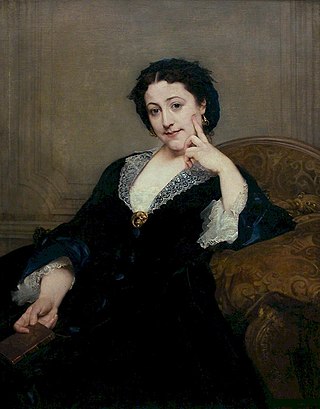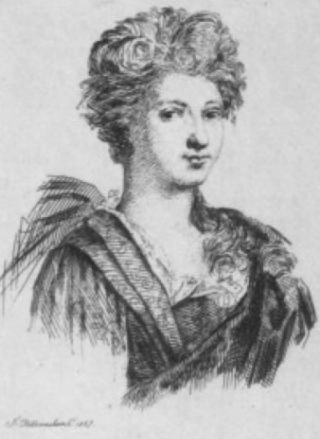
Elisabeth Félix, better known only as Mademoiselle or Madame Rachel or simply Rachel, was a French actress. She became a prominent figure in French society, and was the mistress of, among others, Napoleon III and Prince Napoléon, both nephews of Napoleon I, and of Alexandre Colonna-Walewski, the illegitimate son of Napoleon I. Efforts by newspapers to publish pictures of her on her deathbed led to the introduction of privacy rights into French law.

The Comédie-Française or Théâtre-Français is one of the few state theatres in France. Founded in 1680, it is the oldest active theatre company in the world. Established as a French state-controlled entity in 1995, it is the only state theatre in France to have its own permanent troupe of actors. The company's primary venue is the Salle Richelieu, which is a part of the Palais-Royal complex and located at 2, Rue de Richelieu on Place André-Malraux in the 1st arrondissement of Paris.

Joséphine-Félicité-Augustine Brohan (1824–1893) was a French actress.

Éthélie Madeleine Brohan (1833–1900) was a French actress, also known as Madeleine Brohan. Her name has also been transcribed as Émelie-Madeleine Brohan.

Crêpes Suzette is a French dessert consisting of crêpes with beurre Suzette, a sauce of caramelized sugar and butter, tangerine or orange juice, zest, and Grand Marnier, triple sec or orange Curaçao liqueur on top, flambéed tableside.
The sociétaires of the Comédie-Française are chosen from among the pensionnaires who have been in the company a year or more.

Armande-Grésinde-Claire-Élisabeth Béjart was a French stage actress, also known under her stage name Mademoiselle Molière. She was married to Molière, and was one of the most famous actresses in the 17th-century.

Catherine Leclerc du Rose, also known by her stage name Mademoiselle de Brie', was a French actress. She was a member of the pioneer troupe of both the Molière's company, and of the Comédie-Française. She belonged to the first Sociétaires of the Comédie-Française.

Laurent Stocker is a French theatre and cinema actor, and a sociétaire of the Comédie-Française.
Jean Le Poulain was a French stage actor and stage director.

Gisèle Casadesus was a French actress, who appeared in numerous theatre and film productions. She was an honorary member of the Sociétaires of the Comédie-Française, Grand Officer of the Legion of Honor, Officer of the Ordre des Arts et des Lettres, and Grand-Croix of the National Order of Merit. In a career spanning more than 80 years, Casadesus appeared in more than a dozen films after turning 90.

Georges Berr in Paris, was a French actor and dramatist, a member and sociétaire of the Comédie-Française from 1886 to 1923.

Béatrice Dussan, called Béatrix Dussane, was a French stage actress. Admitted at the Comédie-Française in 1903, she became the 363th sociétaire in 1922. A street in the 15th arrondissement of Paris is named after her.
Denis d'Inès, real name Joseph-Victor-Octave Denis, was a French actor and theatre director for some plays. He entered the Comédie-Française in 1914, was a sociétaire from 1920 to 1953, and General administrator by intérim in 1945.
Julie Bernat, known by her stage name of Mademoiselle Judith, was a French actress.

Berthe Cerny was a French actress, known as an elegant blonde beauty. She had a brilliant career, interpreting both classical and contemporary roles. She had several affairs, including with the politicians Aristide Briand and Paul Reynaud, and had two sons by other lovers. She joined the Comédie-Française in 1906 and became a sociétaire in 1909.

Jeanne-Adélaïde Gérardin (1764–1787), stage name Jeanne Olivier, was a French stage actress.
Pierrette Hélène Pinet, stage names Mademoiselle d'Épinay and Mademoiselle Molé (1740–1782), was a French stage actress.

Catherine-Julie-Clémentine Jouassain, baronne de Tournière was a French actress, a societaire of the Comédie-Française.

Blanche Adeline Pierson was a French actress most notably known for her portrayal of Marguerite Gautier in "The Lady of the Camellias".

















